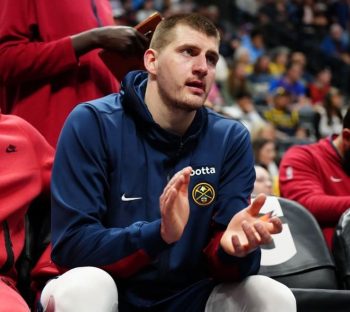NBA
NBA Daily: D’Angelo Russell Back on Track

D’Angelo Russell was traded to the Minnesota Timberwolves last February, just before the COVID-19 pandemic shut down the entire season. But we’ve yet to see what Russell can really do in Minnesota.
The Timberwolves acquired Russell in late February in exchange for a future first-round pick – which transitions this season if they pick later than third – a 2021 second-round pick and Andrew Wiggins.
Sidenote: For those keeping score at home, the Timberwolves currently have the third-worst record in the league with five games remaining. It would behoove Minnesota to lose as many of their remaining games as possible to keep their 2021 pick. If the pick does not transition this season, it becomes unrestricted in 2020.
Trying to turn an owed pick into an unprotected future first is usually the wrong move; but in this instance, it’s better to keep the high first-rounder this year with an understanding that your 2022 pick will probably fall in or around the middle of the lottery.
The thinking around the deal was that Minnesota could qualify for the playoffs as soon as this season by swapping Wiggins’ contract for a young, talented lead guard in Russell. It has not played out as planned.
COVID resulted in a play stoppage shortly after the deal, robbing Russell of the opportunity to ramp up with his new team. When the NBA returned to finish the 2019-20 season, the Timberwolves failed to qualify for bubble play – and considering the US was still battling a global pandemic, Russell couldn’t easily practice with his new teammates and/or coaches.
The 2020-21 season began weirdly, too. The NBA proceeded with an abbreviated training camp and preseason. And while this impacted all teams, Russell was additionally hindered by the decision.
Ready or not, the season began. In 2020-21, Russell is averaging a near-career low in minutes per game (28.2) across just 36 games. He’s tallying 19.1 points per game on 43.6% shooting and a career-best 38.8% on three-point attempts. He’s also he’s posting a near career-best assist-to-turnover ratio (5.7 to 2.8).
Despite Russell’s contributions, the Timberwolves have failed to meet expectations. Far from the playoff squad they hoped to be, Minnesota is in contention for the top pick in this year’s draft. So what has gone wrong in Minneapolis?
Russell’s setbacks are fairly obvious. In addition to the lack of preparation with his teammates and coaches, Russell was diagnosed with a “loose body” in his knee, requiring arthroscopic knee surgery in February. As a result, he missed 27 consecutive games. Russell returned on April 5, but head coach Chris Finch revealed that he’d been on a minutes restriction until just recently.
Minnesota is clearly being cautious with Russell. Upon closer review, Russell has been restricted to under 30 minutes per game in all of his first 10 games back. Since then, Russell is averaging 31 minutes per game including an encouraging 37 minutes on May 5 in a four-point loss to Memphis.
Since returning from knee surgery, Russell is averaging 27 minutes per game across 16 games. Despite starting 19 of the team’s first 20 games, he hadn’t started in any game since returning – until Wednesday.
On the whole, Russell’s impact is about the same as it was prior to the injury, which should be encouraging to Timberwolves’ fans. He’s scoring slightly less (18.8 points since returning vs. 19.3 prior), shooting better from the field (44.9% since returning vs 42.6%% prior) and has been just slightly worse from three-point range (37.4% since vs. 39.9 prior). He’s dishing out more assists per game (6.5 since vs. 5.1 prior), too, and he posted three double-digit assist games in his last five contents – a feat achieved only once all season prior to his last five games.
Despite playing more and dropping more dimes, there’s still room to improve. Looking back to his career-bests, Russell averaged 23.1 points per game in 2019-20 in 33 games with Golden State (23.6) and 12 games with Minnesota (21.7).
But his most impactful season came in 2018-19 with the Brooklyn Nets. That season, Russell averaged 21.1 points and 7.0 assists per game, leading the Nets to the playoffs and earning his first trip to the All-Star game. He looked incredibly comfortable, playing with supreme confidence and flashing the ability to lead a playoff team.
At his best, Russell is a dynamic playmaker. The beauty of Russell is that he can also play off the ball. He has a quick release on his jumper and impressive range. His game is not predicated on athleticism, meaning he should stay at his peak for longer than guys like De’Aaron Fox and Ja Morant.
And while he’s been in the league for what feels like ever (six seasons), Russell just turned 25 approximately two months ago. Granted, comparing anyone to Steph Curry is unwise, but Curry wasn’t Steph Curry yet at 25. Former MVP Steve Nash hadn’t yet averaged double-digits (points) at 25. Twenty-five is also an inflection point for Damian Lillard and Russell Westbrook. And the list goes on.
To be fair, Russell was drafted at 19 so he’s more acclimated to the league at this age than most, but his game will continue expanding nonetheless. He’ll develop trickier moves, become stronger and grow his shooting range. And a good deal of that growth should be evident as soon as next season since he’ll be fully healed from knee surgery and have a full offseason and training camp to finally work with teammates and coaches.
So while Minnesota’s 2020-21 season was incredibly bleak, their future is quite bright – and much of it has to do with the presence of Russell.













